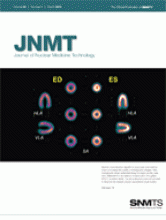
Cybil J. Nielsen MBA, CNMT President, SNMTS
One of the most striking realities of today's job market is a rather uncertain future. Mapping out the future and finding a job are a major concern for all nuclear medicine and molecular imaging professionals—especially recent graduates. Many of you may be wondering what factors contributed to this job shortage and how long it will last. To answer these questions, we must step back and look at the whole picture.
Since nuclear medicine's beginnings, there have been periods of both technologist shortages and job shortages, which tend to be cyclic and occur every 5–7 y. When the field expands, there is an increased demand for nuclear medicine technologists. As a result, new schools open and existing programs increase their enrollment. Then, at a certain point when supply outpaces demand, more technologists are on the market than are needed to fill position openings. This happens in many of the allied health fields; however, because nuclear medicine is a smaller community, the effects may seem much greater.
Compounding matters, this particular job shortage suffers from poor timing. The job shortage cycle hit at the same time as an international economic downturn, an isotope shortage, and a national health-care reform debate. Combined, these factors are making this job shortage even more acute than ever.
As if that were not enough, we have also been hit with a dramatic decrease in Medicare reimbursement. A 21.2% cut to Medicare physician payments was created by the sustainable growth rate formula and passed by Congress. This has led many cardiology offices to decrease the number of studies they do or, worse, close their departments altogether. For the first time in a very long time, we are seeing technologist layoffs.
Many people are blaming this particular job shortage on nuclear medicine programs that have increased their enrollment of students. They began doing so about 8 y ago when there was a technologist shortage. Usually, when the job market suffers, a decline in enrollment soon follows, which leads to fewer graduates and the elimination of the shortage. However, because of the overall economic climate, many people are switching careers and going back to school, delaying this drop of applicants. However, programs are finally seeing a drop in their applicant pools. As a result, educators are also feeling the brunt of this job shortage, with layoffs of their own.
So, what can be done? There is a misconception that these programs are being irresponsible by allowing so many to enter the field and that, as a result, the programs should not be accredited. However, the accrediting bodies that regulate how many students a program enrolls can base that regulation only on the resources of the facility—not on the job market. SNMTS has a task force in place to study this issue; however, because little can be done in a free-market society to control this, we are limited to making recommendations.
As a profession, we should look at the current situation as an opportunity to grow our field. One option we have to help us in this situation is to begin marketing efforts directly to referring physicians. We need to be ambassadors of our profession and let physicians (and patients) know the value of nuclear medicine procedures and therapies. We also need to engage in dialogue with our referring physicians to let them know when 99mTc is available.
SNMTS is well aware of the job shortage, and it continues to be a discussion item for the SNMTS National Council of Representatives as well as the Executive Board. We recognize this as an issue that affects the organization on many levels, and we welcome suggestions to prevent severe job shortage swings in the future.
I believe that we have seen the worst of the technologist shortage and will soon be seeing a recovery. Across the country, the number of applicants to nuclear medicine technology programs is dwindling in response to the job shortage. As a result, programs will likely decrease the number of students they accept, and some programs may close. I hope, though, that when the technologist shortage cycle hits (and it will––it always does), we will not have taken too many steps to reduce our workforce and have to deal with forced overtime and excessive on-call responsibilities as a result.
The current job shortage may seem especially severe because of the surrounding circumstances—but, as in the past, the field will experience an upswing and will once again provide new opportunities for technologists. Nuclear medicine is strong and growing, and the market will eventually correct itself. Technologists should use this period as an opportunity to identify potential areas of growth both inside and outside their individual departments.
Meanwhile, I would like to invite each and every one of you to go online and join the conversation. SNM has several outlets through which you can communicate your opinions and discuss the job shortage, among other issues. Become a fan of SNM on Facebook, follow @SNM_MI on Twitter, and network with other nuclear medicine and molecular imaging professionals on SNM's group on LinkedIn. Links to SNM's social networking sites are on the left navigation bar at www.snm.org. We would love to hear from you, and we appreciate your continued dedication to SNMTS.







